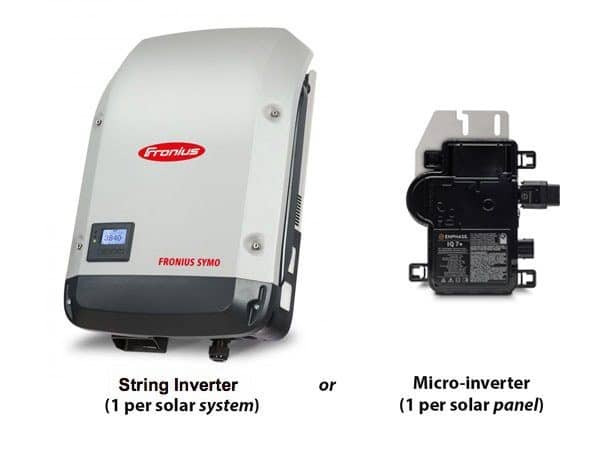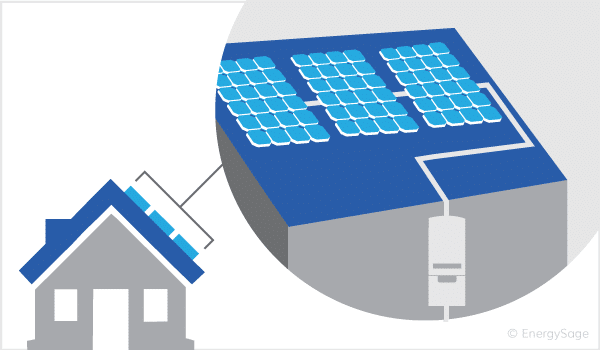Major role of a power inverter is to convert DC (Direct Current) generated by solar panels into an AC (Alternating Current). Alternating current is a type of electric energy required to run your electronic equipment.
Power inverter technology is constantly emerging for the last few decades to allow homeowners to earn maximum electricity from their solar energy systems. Solar inverters like- string inverters and microinverters both do this job meant for you as a PV holder, but their way of working is not similar.
In today’s write up, the Vista EC team is going to discuss what exactly are the string inverters and microinverters and how they do the job?

Points measured in today’s write up are:
- What is a string inverter?
- Benefits of string inverters
- Drawbacks of string inverters
- What is a microinverter?
- Benefits of microinverters
- Drawbacks of microinverters
- Which is best? Microinverters or string inverters?
Let’s go through each point:
What is a string inverter?
This is also known as a central inverter, which is an isolated box, usually fixed near the central panel and power meter. There’s particularly a single solar inverter on every rooftop solar installation and it genuinely depends upon the complete size of the solar panel system.
This inverter works in a series, where there are generally 6 to 10 independent PV panels fixed in a “series”.

Benefits of string inverters
- String inverters are easy to troubleshoot:
The major benefit of a string inverter is that only one inverter is required to convert the Direct Current coming from the solar module to Alternating Current. It’s likely to be a solar inverter that might be going to fail but still, it’s quite easy to troubleshoot things.
- Cost of String inverters:
It’s cheaper to install a string inverter than microinverters. It requires fewer labor hours and at the same time, these inverters are more affordable than a number of microinverters.
- Fewer chances of wiring trouble:
Here, there’re fewer connections between string inverter and photovoltaic panels. Hence the chances of improperly cabling a string inverter reduce as compared to microinverters.
Drawbacks of string inverters:
- Conformity needed with quick shutdown:
If the area where you live adheres to guidelines for quickly shutting down your solar system Perth, then extra labor, as well as wiring, would be required so that your solar system stays within compliance.
Therefore a quick shut down box would be needed to be set up near the electrical service entrance and also control wires would be connected between the power panel and the string inverter.
As the power is emerging from solar PV panels and inside the string inverter itself, you’ll have to disconnect the inverter from both these two places.
Also, the cost of integrating quick shutdown requirements to your solar power system in perth isn’t small, check your local codes and inquire with your solar installer about which solar inverter would be more suitable for your property.
- Productivity in partial shade:
As the string inverters need photovoltaic panels to be connected in series, if the yield of one solar panel gets affected, then the complete series of solar energy panels get affected in some measure. This can lead to a critical issue if some part of a PV panel series is shaded for a particular time of the day.
- Difficult system enlargement:
In order to get perfect performance from a central inverter, it needs to be operating at its peak capacity. Hence when you wish to expand the size of your solar module at one point down the line, these PV panels have to be connected to an individual string inverter, adds extra cost and intricacy.
- Shorter lifetime:
The warranty of string inverters lasts between 8 and 12 years, on the contrary, the microinverters offer a 25-year warranty.
- System monitoring:
It’s not possible to monitor the panel-level insights with a string inverter because no object is attached to the back of every PV panel to do the job.
Whereas total energy production is viewable, you won’t be able to see if there are separate panel performance issues that could be due to a crack, defect, or debris.
What is a microinverter?
Microinverters carry out the same fundamental function similar to the string inverters, except that, these inverters are installed under every individual PV panel on your roof. The size of these inverters is around the size of an internet router.
The biggest difference between the string inverters and microinverters is that a solar system installation with microinverters will mostly have an equal number of microinverters as there are PV panels (Note: Some microinverters accept two or four solar panels.)
Among various microinverters, Enphase is the leading producer of microinverters. These microinverters have been on the Australian market since the year 2009 and have now become an important part of the solar industry. The researchers at Enphase are studying how to apply principles of MPPT (i.e. Maximum PowerPoint Tracking) into their parts to improve PV production.
On the contrary, traditional string inverters can tap into the energy generation of every panel according to the lowest energy-producing panel, this problem doesn’t occur in microinverters, because they work in a parallel circuit.
Having said that, microinverters take complete benefit of the energy generation of the separate panel and convert that energy into the grid voltage. This combination of microinverter and solar panels can work their best in order to contribute as much electricity as they could.
String inverters also have an option for a power optimizer. The power optimizers work in a very similar manner as microinverters, even so, the energy isn’t converted in Alternating Current in the back of the PV panel. That function still gets completed at the central inverter.
Power optimizers are capable of smoothing the voltage and combating the energy production differences, resulting in improved solar energy generation, even during challenging conditions like partly shaded solar power installations.
Benefits of Microinverters:
- Quick shutdown capability:
According to recent power codes, quick solar power system shutdown is important so that firefighters or responders stay safe from the high voltage at the time when they got to be on rooftops or at the time of servicing electricity lines, and in such situations, microinverters quickly comply with quick shutdown needs and also have this ability installed in every solar module.
- More power:
The main benefit of having microinverters is that presumably, you can earn more electricity because there’re few differences in the energies between photovoltaic panels. When solar energy panels are installed with a string inverter, the power gets reduced to that of the lowest energy-producing panel in the string.
- Suitableness for difficult installation conditions:
If a solar energy system, is struggling with multiple angles i.e. few panels are facing south, a few east, and a few west, then microinverters are the best choice to go with. Otherwise, if you’ve shadowing problems due to trees or any other object like a large chimney, then also microinverters would be the best choice.
In these circumstances, the PV panels would produce different amounts of power at different times of the day, but microinverters will make sure that you can utilize all the energy; on the other hand, with a string inverter you’ll lose some of the energy produced.
- Lifetime:
Typically microinverters have 25 yrs warranty whereas string inverters have a warranty between 8 and 12 yrs.
- System monitoring:
You can monitor the electricity production of each individual panel using microinverters and the add-on power optimizers, which is not possible with a string inverter you can just track the energy production of the complete system as a whole.
- Easy to expand the system:
If at any time in the future you want to expand your solar PV system, microinverters are easy to add one by one at a time. Every panel and microinverter duo could be easily added to the existing array without having to worry about buying, sitting, and installing extra string inverters.
The final conclusion is that the microinverters are no doubt a value-add, but they’re recommended only if you require to adhere to quick shutdown necessity, or if your panels are facing multiple orientation problems, or if you’re facing shadowing issues. Else, the less costly string inverter is mostly a more cost-effective option.
Drawbacks of microinverters:
- Cost:
The major drawback of microinverters is the “Cost”. Usually, the cost of microinverters depends to a large extent on the number of panels in the solar energy system and also on their rated output. One microinverter can cost around $200 and usually estimate comes that a solar power system with microinverters will cost about 20% more than an equivalent system with a string inverter.
- Maintenance:
In any case, if one of the microinverters fails, then it would be challenging to detect which one has failed, and also when you detect it, servicing and replacing that component is not easy as compared to a standard inverter.
Your solar installer needs to get up on your roof, work with a solar racking system, unscrew the solar module and replace the microinverters to reconnect alternating current conversion capability.
- Quantity of hardware on your rooftop:
As a microinverter is attached to every photovoltaic panel on your rooftop, that’s a much expensive metal device up there. Microinverters might work as minute lightning rods. So if you’re in an area prone to storm and a historic wooden structure with shaky ceiling material, then you must think twice before installing microinverters.
Which is best for your home? Microinverters vs. string inverters
The majority of microinverter manufacturers claim very slight failure rates, but there are doubts about these claims. Because the inverter is the most complex electronic device in your solar power system, and based on our many years of experience as solar installers in Perth, the most typical thing that fails in a solar module setup is the inverter. Many Australians are reluctant to install 20 independent inverters on a job rather than installing one string inverter. It’s useful only when there are severe shadowing issues.
Even though manufacturers of microinverters sell the ability to monitor every panel as an advantage, they don’t incorporate the monitoring that enables the customer to do this. They allow the solar installers to see this solar panel-level monitoring data from your solar system and not you as a customer, except if you agree to purchase the higher level of monitoring as an upgrade.
That means you, as a customer, could only view monitoring information at a system-wide level and not at the panel level. A non-believer would say that the reason they do this is to secure them and their solar installers from support calls linked to failed inverters. Also, it’s not easy with just system-wide monitoring data to find out only 1 or 2 inverters out of 2 or so have failed.
However, many Australians still like microinverters, as when you purchase a premium solar system with a string inverter, you’ll have to pay extra money for getting the panel-level monitoring, which, as mentioned earlier, gives you panel-level data. Also, when a string inverter fails, the entire system stops working, and it’s easy to identify.
Key takeaways
- Solar inverters convert Direct Current into Alternating Current, which is required for running your home electronic appliances.
- As said earlier, the string inverters are standalone boxes that are mostly appropriate for unshaded solar panel modules on roofs with uniform pitch.
- Microinverters are attached to the back of every photovoltaic panel, and they increase the output of every panel independent of the generation of any neighbouring PV panel, making them smart to use on partly-shaded solar system installations.
- String inverters don’t have their quick shutdown capabilities, whereas microinverters do have.
- Even though the string inverters are more affordable, they don’t have panel-level monitoring capabilities and come with a shorter lifespan of 8 to 12 years. Microinverters come with a 25-year warranty.
